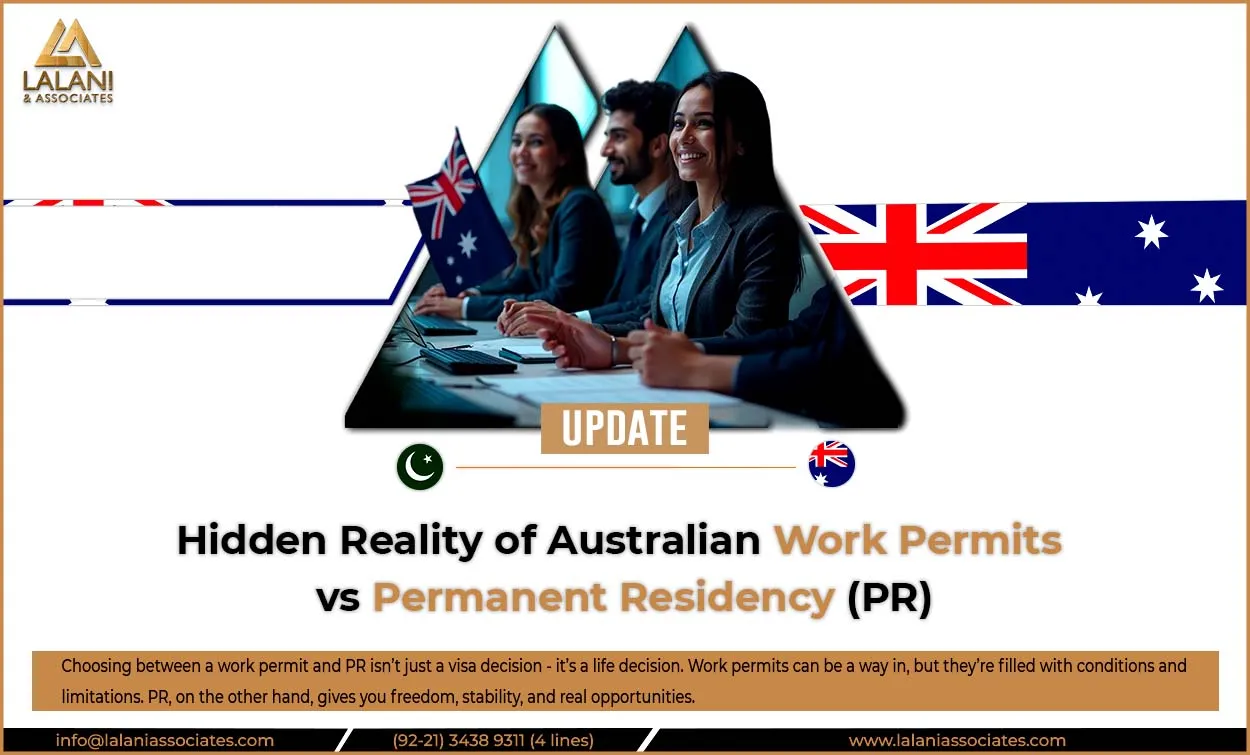
Are you considering relocating to Australia? You're not alone. Australia is not surprising as a top choice for overseas immigrants. The twist is that many eager immigrants choose a work permit instead of filing for Permanent Residency (PR), believing it would be the simpler path.
Spoiler alert: it’s not always the smartest move.
Let's explore the hidden facts about Australian work permits against permanent residency so you may literally make the correct decision!
Understanding Australian Work Permits
What is a Work Permit?
Usually to refer a temporary work visa allowing a foreign individual to work for a designated company under particular terms, a work permit is used in Australia temporary work visa allowing a foreign individual to work for a designated company under particular terms, a work permit is used in Australia Although it's not precisely the golden key to long-term stability, it's a legal ticket to work.
Types of Work Visas in Australia
Temporary Skilled Shortage Visa (Subclass 482)
Most often used work visas are this one. It lets companies sponsor qualified candidates for positions they cannot fill locally.
- Duration: 2-4 years, depending on the occupation
- Tied to employer: Yes. Lose your job? You have 60 days to find another sponsor or leave.
Temporary Work (Short Stay Specialist) Visa
This visa is for short-term, highly specialized work.
- Duration: Usually up to 3 months
- Restrictions: You can’t switch jobs or extend it indefinitely
What Is Permanent Residency (PR)?
Now, let’s talk about PR. A Permanent Residency visa means you’re allowed to live, work, and stay in Australia indefinitely. You’re not just visiting - you’re practically part of the furniture (in a good way).
Common Types of PR Visas
Skilled Independent Visa (Subclass 189)
- No state or employer sponsorship needed
- Fully independent and flexible
- Great for high-demand occupations
Skilled Nominated Visa (Subclass 190)
- Requires nomination by an Australian state or territory
- Slightly faster processing if your skills match the state's needs
Skilled Work Regional Visa (Subclass 491)
- Provisional visa, but leads to PR (via Subclass 191)
- Encourages skilled workers to settle in regional areas
Major Differences Between Work Permits and PR
Let’s break it down:
Duration
- Work Permit: Temporary. You always need to renew or upgrade.
- PR: Permanent. No expiry. Total peace of mind.
Work Flexibility
- Work Permit: You’re tied to one employer or one job type.
- PR: You can work for anyone, in any job, at any time.
Access to Social Benefits
- Work Permit: Very limited - no free healthcare or government help.
- PR: Access to Medicare, public schooling, and welfare support.
Freedom of Movement
- Work Permit: You may need permission to change roles or leave.
- PR: Come and go as you please; no strings are attached.
Citizenship Pathway
- Work Permit: No direct path. You must first secure PR.
- PR: You’re eligible to apply for citizenship after meeting residency rules.
Pros and Cons
Work Permit Pros
- Easier to get in some cases (if employer-sponsored)
- Quicker processing times
- It can help get your foot in the door
Work Permit Cons
- No long-term security
- The employer controls your stay
- Difficult to switch jobs
- Not all work permits lead to PR
PR Pros
- Total freedom and flexibility
- Full access to government benefits
- Better job opportunities and higher salary ranges
- Direct path to citizenship
PR Cons
- Lengthier and more complex application process
- Strict points test and documentation
- May require professional skill assessments
Why Many Applicants Choose Work Permits First
We get it. The work visa looks quicker and simpler, especially if you have an employer ready to sponsor you. It seems like a shortcut, and for some, it is.
But if you're looking to build a life, not just a resume, PR is the way to go.
The Risks Behind Choosing a Work Permit Over PR
The downside of a work permit?
- Job loss = visa loss
- You can’t access healthcare or benefits
- You’re limited in job switching or promotions
- If things go wrong with your employer, your future is suddenly unstable
Long-Term Benefits of PR Over Work Permits
When you have PR, you're no longer walking on eggshells. You can:
- Sponsor family members
- Enroll your kids in public schools
- Apply for bank loans or mortgages
- Access healthcare
- Plan your future without fear of deportation
Real-Life Comparison Scenario
Imagine two applicants:
- Sameer gets a 482 work visa, tied to an IT company.
- M. Hassan gets PR via Subclass 189.
Sameer must stick with the same job, can’t move cities, and gets no healthcare benefits. If the company closes, he's in trouble.
M. Hassan, on the other hand, moves to a better-paying job after 6 months, buys a house, and enrolls his kids in school all stress-free. Can avail healthcare benefits.
Who do you think sleeps better at night?
Mistakes to Avoid in Australian Immigration Planning
- Thinking short-term: Don’t just aim to get in, think about staying!
- Ignoring PR: It may take longer, but it pays off.
- Blindly trusting employers: Sponsorships are helpful, but not guaranteed to last.
Strategic Path Forward
Go for PR if:
- You want long-term benefits
- You qualify on the points test
- You’re serious about settling in Australia
Go for a work permit if:
- You have a clear path to PR later
- You’re temporarily exploring options
- You're confident in your sponsor
Conclusion
While work permits offer quicker entry, they come with limitations and uncertainty. Permanent Residency, though more complex to obtain, provides long-term stability, freedom, and access to vital benefits.
If you're planning a future in Australia, PR is the smarter, safer, and more rewarding path.


0 Comments